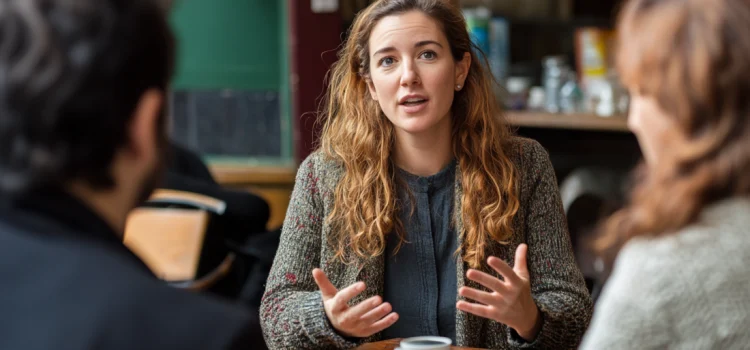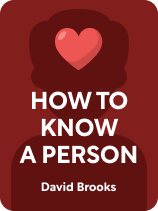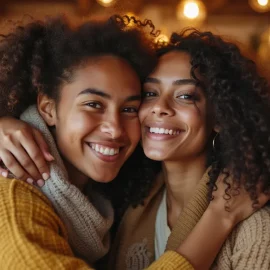

This article is an excerpt from the Shortform book guide to "How to Know a Person" by David Brooks. Shortform has the world's best summaries and analyses of books you should be reading.
Like this article? Sign up for a free trial here.
Do you want to have engaging conversations? How can you show people you’re interested in their stories?
Once you’ve begun to cultivate the skills that help you make others feel understood, you need to engage fully with the stories that others tell you. These stories will most likely be about who someone is, where they’ve been, and where they want to go.
Let’s explore three ways you can learn how to be more engaging in conversations.
1. Practice Asking People the Right Questions
David Brooks writes that the first step to knowing how to be more engaging in conversations is to ask good questions. When you want to discover how someone sees the story of their life, you can’t ask perfunctory questions and expect to get deeply insightful answers in return. For example, Brooks recommends that instead of asking someone what they think about a particular topic, you could ask how they came to think the way they do about that issue.
Brooks contends that, contrary to popular opinion, it’s often OK to ask people big questions: the kinds of questions that we ask as children but get squeamish about posing to each other as adults. He thinks it’s a good idea to ask people questions about what they believe about the world, what kind of person they know themselves to be, and what they value most in their lives. Most people want to tell their story—once you’ve established a trusting relationship with someone, Brooks thinks the chances are good that the other person would welcome a conversation about the big, philosophical questions they rarely get asked.
Brooks recommends that in addition to asking big questions about a person’s philosophy, you can also ask more concrete questions about the things they’ve experienced. For example, as a person tells you about something they’ve done, you can ask detailed questions that help them go deeper into the story and explain what the experience was like for them. Brooks notes that you should always aim to ask questions that invite genuine answers: answers that tell you something about the other person. By asking good questions, you can honor the other person’s ability to make sense of their life, experiences, and beliefs.
2. Help Others See Their Stories (and Themselves) More Clearly
The second step Brooks recommends for going deeper into people’s stories is to engage with those stories with the goal of helping others to tell better stories about themselves. Brooks contends that even as you ask questions to learn the story of someone’s life from their perspective, you can use your perspective to help them see themselves more clearly. We have a natural tendency to arrange our experiences into neat stories. But sometimes, these stories aren’t entirely accurate. Brooks explains that you can pay attention to the ways in which a person’s story doesn’t fully represent who they are or capture the direction their life seems to be going in. Then, you might be able to help them change that story.
He emphasizes that when you listen to someone else’s story, you can simultaneously fully accept and respect them as a person and also help them make their story more honest. In doing so, you help them to see the best in themself and the person they’re becoming. For example, you might have a friend who consistently portrays themselves as always moving forward and never encountering setbacks. You can acknowledge their achievements but also gently point out that the challenges they’ve faced have made them more resilient as a person. By encouraging your friend to include these more difficult episodes in the story they tell, you can help them build a more authentic and balanced view of who they are.
(Shortform note: Brooks emphasizes that we can help others see their stories more clearly, and some psychologists offer a compelling reason why this works. Research shows that our ability to accurately perceive ourselves is often limited, especially when it comes to traits like intelligence, creativity, and extroversion. Our friends and even strangers can sometimes judge these aspects of our personality more accurately than we can. This is partly because we struggle to objectively assess the more desirable traits we have. Plus, our personality leaves traces in many aspects of our lives that others may notice, but we overlook. This means that others’ perspectives are often valuable in helping us develop a more complete and authentic narrative about ourselves.)
3. Recognize the Influence of a Person’s Culture and History
Brooks’s third step to engaging more deeply with people’s stories is to look for the influence of their culture and personal history on the events and choices they’re telling you about. Brooks says some of the key events in a person’s story began long before they were born: in the history of the place they grew up or in the backstory of the people they’re descended from. He believes our ancestors’ history lives on in all of us. So, to really know a person, it helps to learn where they came from and how it impacted their view of the world and their place in it.
Brooks explains that you can simply ask a person how their life has been shaped by their ancestors or by the culture of the place where they grew up. Often, people have ideas about how these influences have shaped their life, their character, and the way they relate to others. But as we discussed earlier in the guide, relying on stereotypes is counterproductive. (That’s why it’s crucial to learn about how a person’s background has impacted them by simply asking them.) Brooks also notes that it’s often wise to get an idea of how closely they identify with or separate themselves from their culture. Not everybody has the same relationship with the people and places they come from, and while the social groups we’re part of provide important context, we can’t be reduced to them.

———End of Preview———
Like what you just read? Read the rest of the world's best book summary and analysis of David Brooks's "How to Know a Person" at Shortform.
Here's what you'll find in our full How to Know a Person summary:
- The benefits of really getting to know other people
- How to better understand people on a personal level
- Why our morality and relationships are in a crisis






